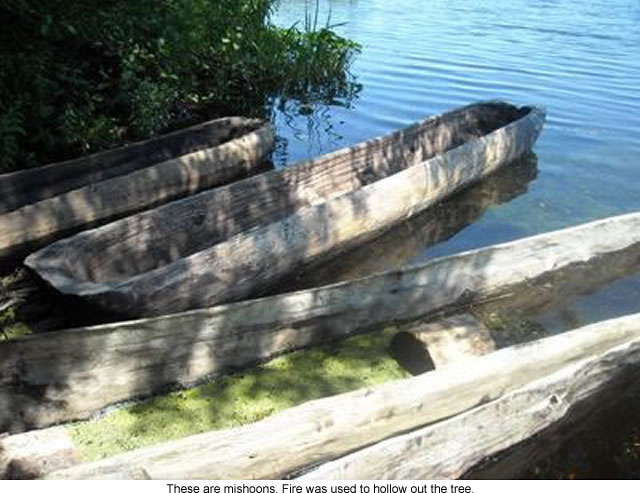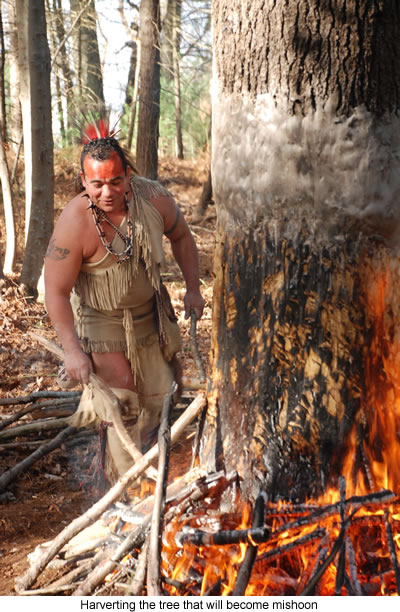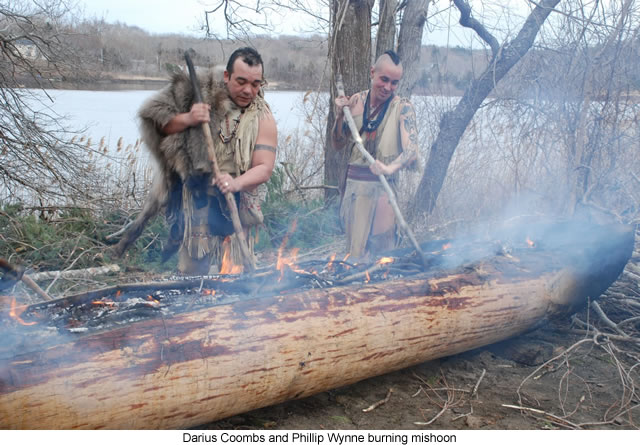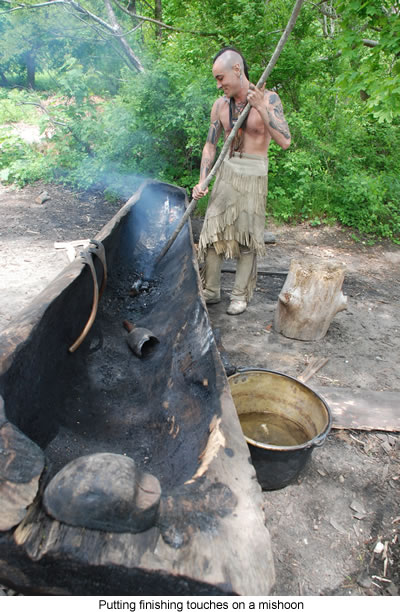 |
Canku Ota
|
 |
|
(Many Paths)
|
||
|
An Online Newsletter
Celebrating Native America
|
||
|
September 2013 - Volume
11 Number 9
|
||
|
|
||
|
Smithsonian's National
Museum of the American Indian Accepts Mishoon (Dugout Canoe) from
Plimoth Plantation into its Collection
|
||
|
by Plimoth Planrtation
press release{byline}
|
||
|
credits: photos courtesy
of Plimoth Plantation
|
|
Plimoth Plantation, Plymouth, Massachusetts—Plimoth Plantation's Wampanoag Indigenous Program (WIP) is proud to announce that a mishoon (a traditional Native American canoe) has recently been accepted into the collection of the Smithsonian's National Museum of the American Indian, one of 19 museums, research centers and zoos that comprise the Smithsonian Institution.
The mishoon was created on the Wampanoag Homesite at Plimoth Plantation this spring. The boat—as well as a companion documentary produced by Plymouth Access Cable Television—will be brought to the Smithsonian's National Museum of the American Indian in Washington, D.C. on September 6, 2013.
"As a museum dedicated to the history and culture of Native American communities, we're delighted to welcome a creation like this one that represents a living tradition among the Wampanoag," says Kevin Gover (Pawnee) Director, National Museum of the American Indian. WIP has close to 40 years of experience in creating mishoons at Plimoth Plantation. During the process for this particular mishoon, they received input from local Mashpee residents Earl Mills, Jr. and Ramona Peters. These two prominent Wampanoag figures also contributed interviews for the documentary. Currently, the mishoon is on display in the Eel River next to Plimoth Plantation's Wampanoag Homesite. It will leave Plymouth for Washington, D.C. the morning of September 5, along with paddles for the mishoon created by WIP. Members of WIP will present the mishoon in a special gift ceremony at the museum's Cultural Resources Center, located in Suitland, Maryland on September 6. "It's an honor that the Smithsonian will accept it, and we enjoy doing new work—it keeps the job challenging," Coombs said. "It has been a fun and educational experience. The mishoon is an invaluable piece that will add depth to the Smithsonian's already rich representation of Northeast Native life."
Plimoth Plantation is one of 177 Smithsonian-affiliated museums throughout the United States. The Affiliations program develops collaborative partnerships with community organizations and provides broad access to the Smithsonian's collections, scholarship and exhibitions. "We have learned a great deal through our partnership with Plimoth Plantation," said Harold A. Closter, Director of Smithsonian Affiliations. "The gift of this invaluable artifact will add depth to our collections and help us expand our educational offerings."Celebrating its 40th anniversary, the Wampanoag Indigenous Program at Plimoth Plantation is based at the Wampanoag Homesite, where Native men and women work as interpreters and wear traditional clothing. Guests visiting the Homesite can learn about Wampanoag history and culture from the 17th century through today.
About
Plimoth Plantation About
the Smithsonian's National Museum of the American Indian |
|
|
||
|
|
||
| Canku Ota is a free Newsletter celebrating Native America, its traditions and accomplishments . We do not provide subscriber or visitor names to anyone. Some articles presented in Canku Ota may contain copyright material. We have received appropriate permissions for republishing any articles. Material appearing here is distributed without profit or monetary gain to those who have expressed an interest. This is in accordance with Title 17 U.S.C. Section 107. | ||
|
Canku Ota is a copyright ©
2000 - 2013 of Vicki Williams Barry and Paul Barry.
|
||
 |
 |
|
|
The "Canku
Ota - A Newsletter Celebrating Native America" web site and
its design is the
|
||
|
Copyright ©
1999 - 2013 of Paul C. Barry.
|
||
|
All Rights Reserved.
|
||

 During
the 17th century, the mishoon was the most common boat in North
American waters. Darius Coombs, Associate Director of the Wampanoag
Indigenous Program, reached out to the Smithsonian and offered to
donate a mishoon to the museum's collection in Washington, D.C.
Work began on the mishoon in the spring of this year. The completed
canoe is 16 feet long and can fit up to 3 people.
During
the 17th century, the mishoon was the most common boat in North
American waters. Darius Coombs, Associate Director of the Wampanoag
Indigenous Program, reached out to the Smithsonian and offered to
donate a mishoon to the museum's collection in Washington, D.C.
Work began on the mishoon in the spring of this year. The completed
canoe is 16 feet long and can fit up to 3 people.
